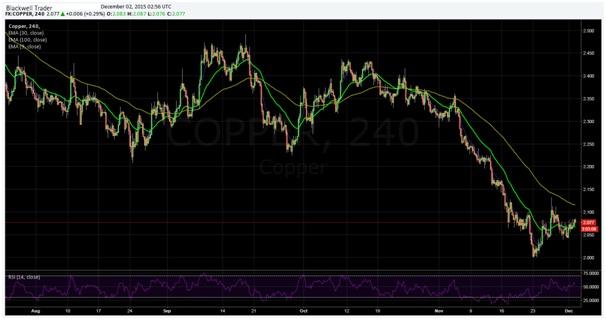2015 has been a relatively down year for copper prices as a combination of slow growth in supply and diminished demand have ravished the commodity. However, despite a relatively static level of supply, prices continue to decline and many are now asking what lays ahead for the industrial metal.
Over the past year, copper bulls have continued to point towards a rebalancing of equilibrium for the metal and the fact that significantly lower prices would eventually cause some mines to shutter their operations. However, 2015 has seen copper prices decline over 20%, whilst supply has actually seen a small increase. Subsequently, global copper prices have remained under significant pressure and the implications of the current over-supply are likely to remain in place for the near future.
In fact, the potential for an imminent increase in supply growth is a significant concern to copper markets. During the copper boom period, large CAPEX programs were undertaken with the expectation of expanding demand. These capital investments are now nearing fruition and could place a significant strain on an already over-supplied market. Based on the current known CAPEX programs, there is potential for at least another 1.4mtpa to enter the market by the end of 2017.
Much of the modelling undertaken within the copper industry has presupposed that this additional supply would be absorbed by growing Chinese demand into 2017. However, given the recent concerning growth indicators emanating from China that assumption must be questioned. This is an especially prescient point given the economic transition that is occurring within the Asian powerhouse’s domestic industries towards more service based endeavours. Although that pivot is likely to take the better part of a decade, growth in copper demand from China is most definitely not assured.
In fact, modelling undertaken by Goldman Sachs points to an increasing divergence between supply and demand. Despite evidence that some rebalancing is occurring within inventory stocks and the lack of visible refined metal, much of the stock is currently being held back in concentrate and SRB inventories. This means that those often underreported stockpiles will continue to grow as global macroeconomic and inflationary conditions remain lack lustre.
In conclusion, growing supply capacity will continue to put copper prices under pressure despite the potential for moderate gains in demand. In addition, much of the current pricing modelling is predicated upon a strong Q4 result from China, which I possess little conviction in. Subsequently, I disregard many of the current analyst opinions pointing to a pricing range around the $4,800/t level by years end. Instead, given the likely depth of the Chinese domestic slow down, coupled with additional productive capacity, my modelling points towards pricing around $4,000/t by the close of Q1, 2016.
Risk Warning: Any form of trading or investment carries a high level of risk to your capital and you should only trade with money you can afford to lose. The information and strategies contained herein may not be suitable for all investors, so please ensure that you fully understand the risks involved and you are advised to seek independent advice from a registered financial advisor. The advice on this website is general in nature and does not take into account your objectives, financial situation or needs. You should consider whether the advice is suitable for you and your personal circumstances. The information in this article is not intended for residents of New Zealand and use by any person in any country or jurisdiction where such distribution or use would be contrary to local law or regulation. Knight Review is not a registered financial advisor and in no way intends to provide specific advice to you in any form whatsoever and provide no financial products or services for sale. As always, please take the time to consult with a registered financial advisor in your jurisdiction for a consideration of your specific circumstances.
Recommended Content
Editors’ Picks
AUD/USD hovers around 0.6500 amid light trading, ahead of US GDP

AUD/USD is trading close to 0.6500 in Asian trading on Thursday, lacking a clear directional impetus amid an Anzac Day holiday in Australia. Meanwhile, traders stay cautious due ti risk-aversion and ahead of the key US Q1 GDP release.
USD/JPY finds its highest bids since 1990, near 155.50

USD/JPY keeps breaking into its highest chart territory since June of 1990 early Thursday, testing 155.50 for the first time in 34 years as the Japanese Yen remains vulnerable, despite looming Japanese intervention risks. Focus shifts to Thursday's US GDP report and the BoJ decision on Friday.
Gold price lacks firm intraday direction, holds steady above $2,300 ahead of US data

Gold price remains confined in a narrow band for the second straight day on Thursday. Reduced Fed rate cut bets and a positive risk tone cap the upside for the commodity. Traders now await key US macro data before positioning for the near-term trajectory.
Injective price weakness persists despite over 5.9 million INJ tokens burned

Injective price is trading with a bearish bias, stuck in the lower section of the market range. The bearish outlook abounds despite the network's deflationary efforts to pump the price. Coupled with broader market gloom, INJ token’s doomed days may not be over yet.
Meta Platforms Earnings: META sinks 10% on lower Q2 revenue guidance Premium

This must be "opposites" week. While Doppelganger Tesla rode horrible misses on Tuesday to a double-digit rally, Meta Platforms produced impressive beats above Wall Street consensus after the close on Wednesday, only to watch the share price collapse by nearly 10%.
